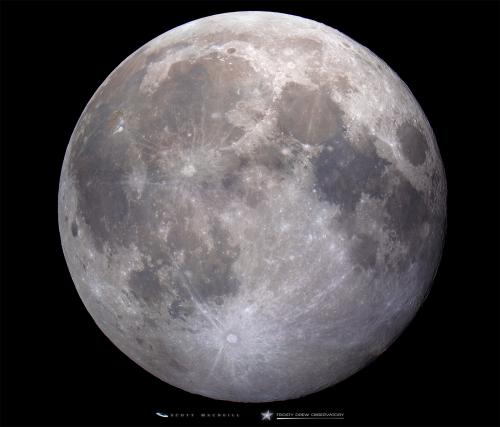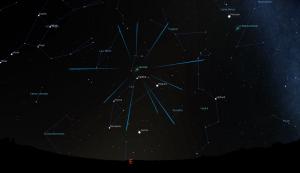November Skies Have Something for Everyone
“Looking at the stars always makes me dream, as simply as I dream over the black dots representing towns and villages on a map. Why, I ask myself, shouldn’t the shining dots of the sky be as accessible as the black dots on the map of France?” —Vincent Van Gogh, 1889.
While we still cannot physically reach the stars, our spacecraft have probed the distant regions of our solar system. Although marvelous instruments have imaged the universe in all wavelengths of the electromagnetic spectrum, you and I can experience the majesty of the heavens using our eyes, binoculars, and modest-sized optical telescopes. Fortunately the often clear and transparent skies of November will be host to a wide variety of objects and events to satisfy the exploratory nature of the casual and amateur stargazer alike.
Annually during the first two weeks of November the Earth passes through a stream of debris left in orbit by Comet Encke. These often very bright meteors comprise the Taurid (Northern and Southern) meteor showers. The Taurids are fairly slow and enter our atmosphere at approximately 17 miles per second, resulting in yellow fireballs that often explode and fragment into multiple meteors. Concentrate your gaze toward the constellation Taurus the Bull (find the V-shaped pattern that defines the bull’s face, or locate the Pleiades — the Seven Sisters), but scan around since the Taurids can appear anywhere in the sky. At best, one can expect no more than six meteors per hour.
On Sunday, November 6 at 2:00 a.m., don’t forget to set your clocks and devices (older units don’t automatically accomplish this task) back one hour as we return to Eastern Standard Time (EST) from Eastern Daylight Time (EDT). Everyone knows the phrase, “Spring ahead and fall back/behind.” Failure to fulfill this ritual will result in your being one hour early until you remember to do so.
Furthermore, during the first week of November above the western horizon shortly after sunset, you can still catch a glimpse of Saturn, with brilliant Venus to its left. Higher in the sky to the left you can continue to see reddish Mars. You’ll need a good unobstructed horizon to view Venus and Saturn through a telescope, and Mars is so distant from the Earth at this time that little detail can be viewed on its surface. Throughout this period a waxing crescent Moon will glide above this planetary grouping. Saturn will soon be lost in the solar glare, while Venus will continue to rise higher into a darker sky as the year progresses.
Throughout November one can still observe the Milky Way as it stretches from the constellation Cygnus towards the western horizon. A dark sky will reveal the myriad of stars of our home galaxy, and even a pair of binoculars will show beautiful clusters of stars within its boundaries. And if you have a small telescope, just scan up and down its length with a wide-field eyepiece. You’ll be rewarded with many fine views of dense star fields.
For those of you who have a good view towards the northern sky, Ursa Major (Big Dipper) sits above the horizon after sunset this month. Watch as the handle of the dipper sinks below the horizon as the constellation rotates counter-clockwise around Polaris, the Earth’s pole star.
Also after sunset you can find the constellation Taurus the bull rising above the eastern horizon. You can recognize this star pattern because it contains two beautiful star clusters. The Pleiades, or Seven Sisters, is easily recognizable, as is the V-shaped cluster called the Hyades. This open cluster contains Taurus’ bright red star Aldebaran, the bull’s eye. Orion rises soon thereafter. Unfortunately that early evening appearance signals that winter will not be too far behind.
On the 14th the closest Full Moon since January 26, 1948 occurs. In recent years the term supermoon has been used to describe a lunar close approach. But a supermoon is really nothing special. The Moon’s elliptical orbit about the Earth produces one perigee (close approach) and one apogee (farthest distance) each month. These extremes vary each time they occur. This upcoming perigee will be the closest (221,524 miles) until November 25, 2034 (221,486 miles). Tides will be high, so let’s hope there are no coastal storms.
Just three days later is the peak of the annual Leonid meteor shower during the early morning hours of the 17th. Unfortunately a waning gibbous Moon on the Gemini/Orion border will overshadow all but the brightest meteors of this display. This scenario is further compromised because the Leonid peak rate is down to its normal level of perhaps 10-15 green or blue shooting stars per hour. The Leonids blaze across the sky at around 44 miles per second as they hit the Earth’s atmosphere nearly head-on. The resulting display produces many fireballs, with about half of them leaving trains of dust that can persist for minutes. The area of sky where the meteors appear to radiate from is in the Sickle (backwards question mark) asterism in Leo. Best of luck in seeing a handful of shooting stars.
And finally, throughout the month, please visit one of the local observatories and ask the telescope operators to show you the two most distant planets of our solar system. Since the demotion of Pluto to dwarf planet status in 2006, those planets now are Uranus and Neptune. These gas giants look like little blue-green disks through a telescope. You won’t see any detail, but you can boast of catching a glimpse of these distant worlds.
Seagrave Memorial Observatory in North Scituate is open to the public every clear Saturday night. Ladd Observatory in Providence is open every clear Tuesday night. The Margaret M. Jacoby Observatory at the CCRI Knight Campus in Warwick is open every clear Wednesday night. Frosty Drew Observatory in Charlestown is open every clear Friday night year-round.
Be sure to check the websites of these facilities before venturing out for a visit.
Great American Total Solar Eclipse on August 21, 2017. Countdown: 292 days as of November 1, 2016.
Keep your eyes to the skies.
David A. Huestis
- Author:
- David Huestis
- Entry Date:
- Nov 1, 2016
- Published Under:
- David Huestis's Columns





